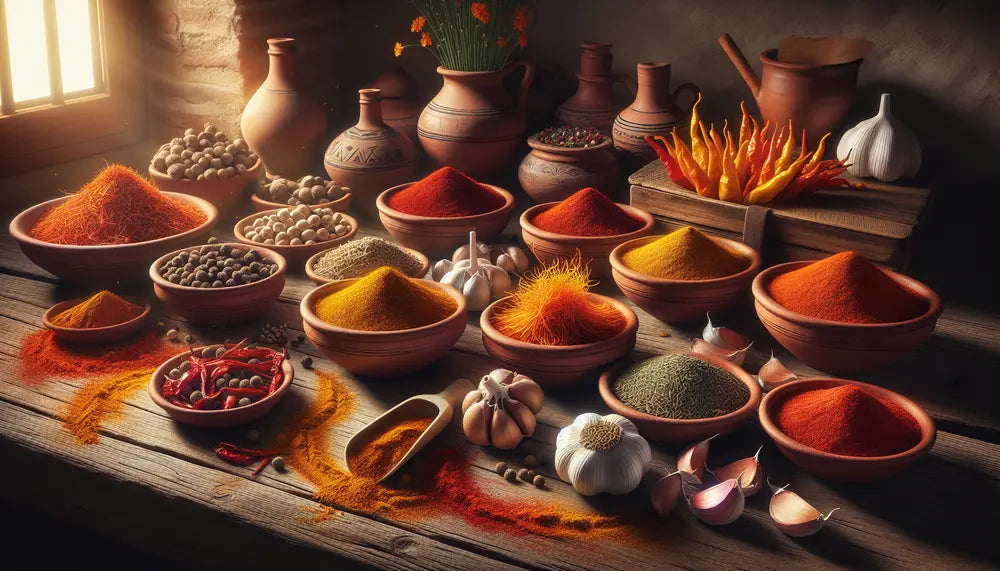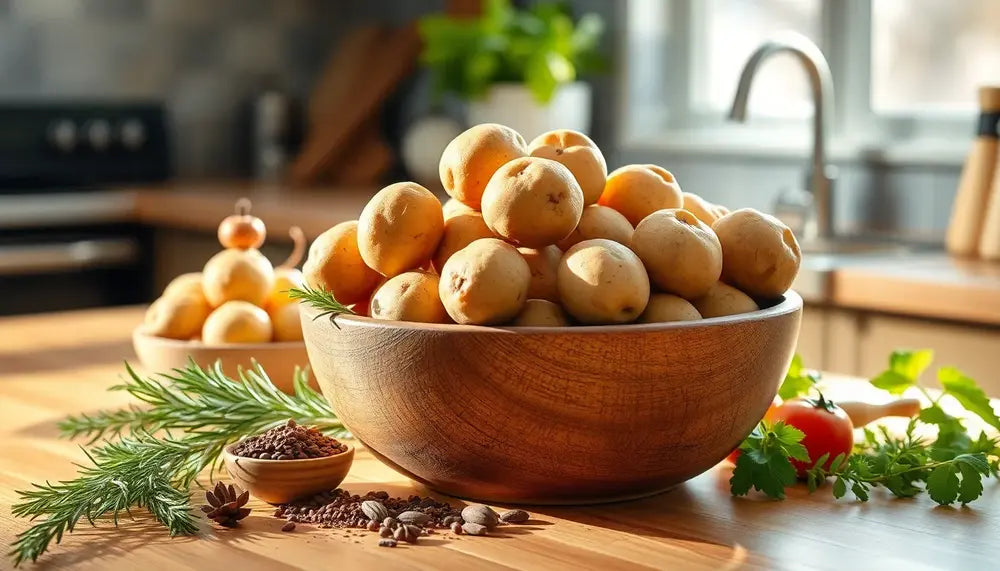The importance of spices in Spanish cuisine
Spanish cuisine is world famous for its diversity and intensity of flavors spices play a central role. In Spain, using spices is not just about making food tastier. Spices are an essential part of cultural identity and history. From the markets of Andalusia to the taverns of Catalonia, spices shape Spain's culinary heritage.
Traditionally used spices such as saffron, paprika and bay leaves are more than just ingredients; they are an expression of Spain's regional diversity. These spices give classic dishes such as paella, tapas and chorizo their distinctive flavors. They also play an important role in religious and festive occasions that shape the Spanish way of life.
Not to be forgotten is the health component that many Spanish spices bring with them. Studies suggest that regular consumption of certain spices can help prevent various diseases. This reflects the deep connection between Spanish cuisine and a healthy lifestyle.
In summary, spices in Spanish cuisine are crucial not only for flavor but also for promoting a rich cultural and healthy lifestyle. They are indispensable components that make every bite not only a taste experience, but also a culinary journey of discovery.
Typical Spanish spices and their use
There are a few in Spanish cuisine spices particularly characteristic and shape the unmistakable taste of the dishes. Here is an overview of typical Spanish spices and their typical application:
- Spanish saffron – Highly valued for its unique aroma and coloring power, saffron is traditionally used in paella, fish soups and rice dishes.
- Rosemary – This aromatic herb finds its application in meat dishes, especially lamb and chicken recipes, as well as in stews and sauces.
- Thyme · Often used in combination with other herbs to refine braised dishes and pates.
- Bay leaves – A classic spice for stews, soups and when preparing fish. They are usually removed at the end of the cooking time.
These spices are valued in Spanish cuisine not only for their taste, but also for their ability to enhance and enhance the flavors of the natural ingredients. 1
The uses of spices are as diverse as the Spanish landscape itself, and each spice contributes its own history and tradition.
Advantages and disadvantages of famous Spanish spices
| Spice | Advantages | Disadvantages |
|---|---|---|
| Saffron | Intense aroma, promotes digestion | Very expensive, excessive consumption can be unhealthy |
| Pimentón (peppers) | Versatile, rich in vitamin C | May cause stomach irritation if consumed in excess |
| Chorizo spices | Adds a spicy touch to dishes, good source of fat | May be too spicy for some palates, often contains a lot of salt |
Saffron: The golden spice of Spain
Saffron, often called that golden spice of Spain plays a prominent role in Spanish gastronomy. This spice is popular not only because of its intense color and unique taste, but also because of its diverse uses in the kitchen.
The extraction of saffron is notoriously labor-intensive as the saffron threads have to be plucked by hand from the flowers of the saffron crocuses. This activity, which takes place mainly in the La Mancha region, typically takes place in October when the crocuses are in bloom.
In the culinary sector, saffron is mainly used to flavor rice dishes, such as the famous one Paella, giving it a golden yellow color and a spicy aroma. But the spice is also used in soups, seafood dishes and sauces and provides a depth of flavor that is rarely found in other cuisines.
Additionally, saffron is valued in Spain for its supposed health-promoting properties. It is said to have antioxidant properties and to have a positive influence on vision and mood.†
The importance of saffron to Spanish cuisine and culture cannot be overstated. Not only does it give many traditional dishes their characteristic color and flavor, but it is also a symbol of Spain's rich cultural history.
Paprika: A versatile spice in Spanish gastronomy
Paprika, also known as pimentón in Spain, is another central spice that is incorporated into many facets of Spanish cuisine. From mild to spicy, paprika offers a range of flavors that make Spanish dishes unmistakable.
In Spain there are three main types of peppers: sweet (dulce), bitter-sweet (agridulce) and sharp (picante). This variety allows the spice to be used flexibly in various recipes, from meat dishes to vegetarian dishes.
Paprika plays a special role in the production of Chorizo, a spicy Spanish pepper sausage. Here it not only gives the characteristic red color, but also the spicy aroma that makes chorizo known worldwide. It is just as important for the preparation of stews and ragouts, where it contributes a deep seasoning.
The regional differences in the use of peppers are clearly visible in Spain. While some regions prefer the spicy version, others prefer the milder forms. This regional flavor shapes the identity of Spanish cuisines and shows how a single spice can take on a variety of forms.
In addition to its culinary importance, peppers are also valued for their health benefits. It is rich in vitamin C and antioxidants†, which can help protect the body.
Paprika's flexibility and deep-rooted tradition in Spanish cuisine make it an indispensable part of Spain's gastronomic landscape.
Chorizo and Pimentón: A spicy combination
Chorizo and Pimenton are among Spain's most iconic flavors and together form a spicy combination used in many traditional dishes. This combination not only gives the food a deep red color, but also a deep, complex aroma.
The composition of chorizo usually includes pork seasoned with pimentón, as well as other spices such as garlic and salt. The type of pimentón used determines the spiciness of the sausage: from sweet and mild to strong and spicy.
Chorizo is made by combining ingredients, followed by a curing process in which the sausage is air-dried. This process enhances the flavors and creates the typical texture. Traditionally, chorizo is cut into thick slices and can be served both boiled and fried, or as part of stews and tapas.
The use of pimentón in chorizo is not only crucial for flavor, but also has preservative properties that play an important role in traditional Spanish food processing.
In Spain, this spicy combination is often enjoyed at festivals and family gatherings and is an integral part of hospitality and culinary pride. The enthusiasm for chorizo and pimentón shows how deeply rooted and essential these ingredients are in Spanish cuisine.
Modern and traditional use of spices in Spain
In Spain, the use of spices is a bridge between tradition and modernity. While classic recipes continue to be cherished, contemporary chefs are experimenting with these flavors to create innovative dishes.
Spices such as saffron, pimentón and bay leaf are traditionally used in the preparation of regional specialties. This deep roots in Spain's culinary history is evident in dishes such as paella, which would be unthinkable without saffron, or chorizo, which owes its characteristic taste to pimentón.
However, modern Spanish cuisine takes the liberty of reinterpreting these spices. Modern fusion cuisines focus on using spices in less traditional contexts, such as in avant-garde desserts or in cocktails. This innovative approach has resulted in traditional spices experiencing a renaissance and appearing in new formats that fascinate both locals and tourists.
The use of spices in Spain is therefore an exciting field that both preserves traditions and opens up new gastronomic horizons. This duality reflects the respect for history and an openness to innovation that makes Spanish cuisine so unique and vibrant.
Whether old or new, spices are an inexhaustible source of inspiration and help ensure that Spanish gastronomy both honors its roots and remains forward-looking.
Buying and storing spices: tips for lovers of Spanish cuisine
For lovers of Spanish cuisine, it is essential to have the right ones spices to buy and store optimally to preserve the authentic aroma of Spanish dishes. Here are some practical tips to get the most out of your spices.
- Purchasing high-quality spices: Prefer spices from specialized stores or from trusted online suppliers that offer fresh products. Pay attention to the country of origin and the date of processing.
- Proper storage: Spices should be stored in airtight containers in a cool, dark place. Light, heat and humidity can weaken flavors and shorten shelf life.
- Portioning: Buy spices in quantities that you can use within a year. Freshness is crucial for the taste of spices.
To preserve the maximum freshness and flavor of the spices, it is also advisable to purchase whole spices and grind them just before use. Tools like a mortar or spice mill are ideal for this.
With these tips you can ensure the quality of your Spanish spices and take your cooking skills to a new level. Whether you're sprucing up a simple dish or preparing an elaborate menu, proper care and handling of your spices will make a noticeable difference.
Conclusion: How Spanish spices can enrich your kitchen
Introducing Spanish spices into your kitchen can be a real enrichment for more than just... Flavor explosions but also builds a culinary bridge to a rich cultural tradition. Spanish spices offer an unparalleled variety, ranging from sweet and mild to hot and intense notes.
They open up new culinary perspectives and offer the opportunity to authentically recreate traditional dishes or develop your own creations. The use of Spanish spices makes every meal not only a culinary delight, but also a small celebration of the Spanish way of life.
Result: Spanish spices are more than just additives; they are a gateway to a world of flavors that can enliven and enrich your kitchen routine. Embrace the adventure of Spanish spices and be inspired and enchanted by their diversity.
Whether you are an experienced chef or an enthusiastic beginner, Spanish spices are an asset that will expand your culinary skills and transform your meals into an enjoyable experience.
FAQ: Discover Spanish spices
What are typical Spanish spices?
Typical Spanish spices include saffron, pimentón (paprika), rosemary, thyme and bay leaves. These spices shape the unmistakable taste of Spanish cuisine.
How to use saffron in Spanish cuisine?
Saffron is primarily used in dishes such as paella, where it provides the golden color and aromatic flavor profile. A small amount is enough to give a dish rich color and distinct flavor.
What are the health benefits of Spanish spices?
Many Spanish spices such as paprika and saffron are known for their antioxidant properties and can contribute to overall health promotion.
Can you easily use Spanish spices at home?
Yes, Spanish spices are easy to use in everyday recipes to add an authentic Spanish touch to any dish. Simple dishes like fried chicken or vegetable stews can be refined with spices like pimentón or rosemary.
How do you store Spanish spices correctly?
Spanish spices should be stored in airtight containers in a cool, dark place to preserve their freshness and flavor notes. Avoid storing them in direct sun or damp areas.





Share:
Spices with the letter N
Grill master tips: Grilling spices for the perfect barbecue experience